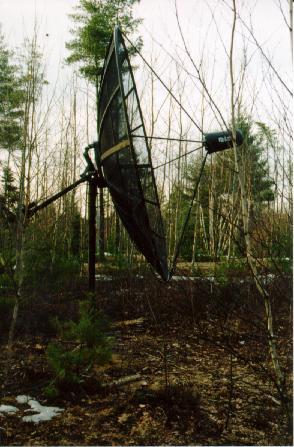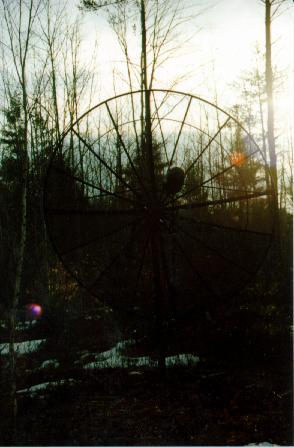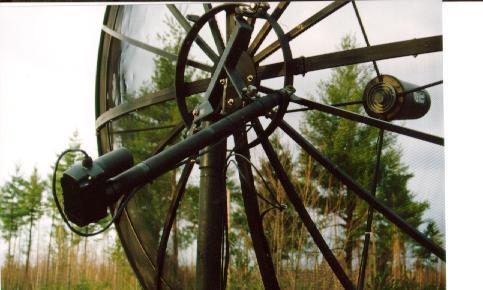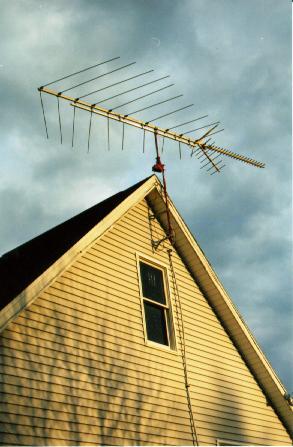TVRO Installation
in
Well after some playing around in my "side yard" my Big Ugly Dish (BUD) is up and receiving. This page is the story of how it all happened. Perhaps it will contain some helpful hints for other newcomers to the BUD world. Maybe not, but here it is anyway.

The Beginning
The real story began many years ago while reading Radio-Electronics magazine. I won't go that far back though, suffice to say they had an article on how to build a satellite receiver. It sufficiently whet my appetite and spawned a dream.
This past fall (1996) I purchased a house, with 5.01 acres. The dream came alive once more. Lacking funds to buy a new system, I took to the Sunday paper. Figuring all the new "digital" dishes would create a massive big dish market. This failed miserably. There seemed to be nothing there, other than commercial Silly Little diGital diSh (SLuGS) ads. Then, looking through the local trade-and-swap magazine Uncle Henry's I found several used BUD's being offered. Some priced very high and a few for free (mostly parts in the latter category). The difficult part was that no one seemed to be able to classify BUD's in any of the classified categories. I found some under Home Entertainment, some listed under appliances, and the ever popular miscellaneous.
So the routine continued, then one rainy Sunday I came across an ad for a "complete 10" satellite system for $800." I called, and got the address. "Humm, Bryant Pond ... only about an hour drive from here", I thought. "I could be back for my 5:00pm dinner arrangements." An hour drive here in Maine aint that fur. So off I went, into the snow and rain, to look at a big wet bud.
The Dish
I got there, into this valley. When I say valley I mean valley. Brynat Pond is smack dab near Ski territory (can you say Mountains?). The dish nicely situated in a 100 foot deep ditch with a clear view of rocks, trees, and mountainsides. And situated right nearby, to my silent delight, was a miniature PrimeStar dish.
All together the guy had a complete system, currently installed and working. It included nearly everything I needed; a 10 foot black-mesh dish, polar mount, 24 inch actuator, about 100 feet of beat-up cabling, a Panasonic IRD, and a VideoCipher IIrs module. His problem was that he could only get a few satellites from his location (duh) and was so upset, he did the PrimeStar thing. Their satellite was one of the few he could see. After checking out the system in it's working condition, I made my offer.
Then the fun began. I'll tell you this right now, disassembling a 10 footer in snow and rain with a broken wooden step ladder and a Toyota 4x4 pickup's bed is not an adventure for the faint of heart. But my excitement was to big to control. With wet cold hands and a few wrenches I went at it. Inside the seller disconnected the IRD and began pulling the existing cable out of the house and ground. About half of the cable came out O.K. Outside however, frost had set in so we had to cut the cable on either end. I ended up with about 100 of the 150 feet, as two pieces The dish itself separated into four pieces (quads), the polar mount and the actuator. This all fit nicely in the bed of my pickup. The one thing I had to leave behind (besides the 50" of cable) was the mounting pole. Not quite sure how I would have dug a cemented 4 inch steel pipe out of frozen earth even if I wanted to!
I did manage to get home fast enough to "unpack" before dinner, but I had to wait until Monday to have any fun with the system. When I did get down to the basement with all the gear I  assembled as much as I could and connected up all the wires to ensure it was all working properly. I and stopped at the hardware store to pick up some flat black paint and rust protection.
assembled as much as I could and connected up all the wires to ensure it was all working properly. I and stopped at the hardware store to pick up some flat black paint and rust protection.
A local salvage yard supplied me with a complimentary 12 foot section of Schedule 40 Steel pipe. I arrived at the salvage yard and asked the operator if they had any 4 inch outer diameter or "Schedule 40" pipe. His typical Mainer response was, "dunno, you betta go look fur yerself. Pipes and all is outside 'round tha cornah." Well sure enough, just waiting for me was perfect 12 foot Black (mostly) 4 inch diameter Schedule 40 pipe, with welded on do-hickeys about a foot from one end. The do-hickeys were just right for ressiting twisting in the sandy soil of my yard. Back inside I inquired about the price for the pipe I had located. And the ensuing conversation was quite unique. "I found a section of pipe that will work for what I need, how much do you want for it?" I asked. "Can you lift it?", he responded in sort of an annoyed tone. "Guess so", I replied, "I didn't try." "If you can lift it take it", he said. I thought to myself as I walked out the door, "For free I'll lift that truck over yonder." And to that, my parting words were, "Thanks!"
I spent the next few weeks patching tears in the mesh and popping out dents, etc. I painted the whole thing flat black to hide the scratches and make it look nicer. Unfortunately I had a work trip scheduled to San Diego the following week and could not plant my new toy in the yard just yet. I was getting nervous that the ground would freeze up and I would have to wait until spring. Fortunately, the weekend after I returned the weather was nice and the ground not yet frozen (my house is a bit south of Brynat Pond.)
Installation
Work started the proceeding Thursday, when I dug the hole. We have sandy soil, so I dug about 5 feet down. It went pretty quickly but I had not yet purchased concrete to mount the pole in yet, so I had to quit for the evening. Friday on the way home from work I stopped at HQ, the local all-encompasing home supply store, and picked up some QuickRete fast setting concrete. It was cold enough out to perhaps cause problems with regular concrete. When I got home I went right to it. Using some support posts (2x4's) and a fence-post level I picked up as well to hold the pole plumb I poured and mixed the concrete. I have also been insulating my second floor, so I used some insulation to cover the finished pour and keep the heat in so the concrete would cure and not freeze. I let it cure until Sunday. Everything was working out wonderfully, the dream was fast becoming a reality.
Sunday, perhaps "Super Sunday" would be a better name. I called my friend Dave in the morning to help me "launch" the dish onto the post. While waiting for him to arrive, I assembled the four sections of mesh in the yard. He arrived just in time to help me attach the feed horn and LNB assembly. To help minimize any focal distance problems, I marked down which holes the previous owner had installed the assembly at. I simply reassembled it in the same position. We mounted the dish onto the polar mount, backed up the pickup and ugh lifted it up and on to the post. Now the tricky part began.
Getting the dish to point True South would have been much easier if so many directions did not try to take magnetic variation into account. Being an avid camper and hiker, I had a decent compass that was already adjusted for such variations in my area. I started by tightening up the mounting bolts on the mount with the dish at its peak and pointing roughly south. In putting the heavy weight of the dish on the post, it dragged it slightly out of plumb (straight up and down). Using the mounting bolts, which are on the dish side of the mount, I re-plumbed as good as I could while still leaving some play for alignment. Then I continued by using an inclinometer purchased from HQ to adjust the proper elevation. Which was only a few degrees from where the previous owner had it set. Using the compass again, I got the polar mount pointing as close to south as possible.
We scurried back and fourth bringing the IRD, TV, extension cord, and cables out from the house. We set the TV up in the cab of my pickup, it had started a light drizzle, and powered up. Then I started to scan, looking for a signal ... any signal. We found absolutely nothing. Neither Dave nor I had ever done a dish install before, but it seemed quite odd to both of us, admitted computer hardware hackers, that we did not even get white noise, static, humms, hisses, or anything at all. We swapped a few coax cables (the C and Ku Feeds on the purchased cable) and still got nothing. I resorted to running inside and grabbing a surplus 50 foot coax that I had left over from other projects and screwed it on. Almost instantly *poof* we were watching NHK, Japanese news. The picture was not that good, but we both stared at it for about 10 minutes in sheer awe.
Now that the bad cable was eliminated, Dave will tell you that it was the new "ends" I had installed on the old cable, we began to scan the arc and see what we could see. The IRD had been programmed with a few satellites, but I quickly reset the memory realizing my coordinates would be different depending on how the actuator was situated. We scanned about and made some micro adjustments to the dish position, a little east here, a little west there, push up, push down, looking for the best picture. I did not at the time do a full peaking of the dish, it was just too exciting to watch stuff coming out of the sky.
After a while of just watching, we began the formal peaking of the dish. Our previous playing, and consultation with various "How to Install a Satellite Antenna" documents led us to point at a bird nearly due south from us, a little west of south actually. I pointed the dish where I thought the bird might be and loosened up the mounting bolts. Swinging the dish east and west a bit and *bingo* came the bird. Having "locked-in" the first bird, the mount was tightened up. Then the scan began again, looking for other birds. Nothing ... absolutely nothing. No, Not again! What had we done wrong? We checked and rechecked every angle, every inclination, declination, wire, cable, plug, cord, level, plumb, was the cat eating, trees that blew in the way, big explosions in the sky, anything? Nothing. Dave had to take off for another engagement, and left me, satelittleless.
Peaking and Programming
I continued, for a while and was just about to give up. I think I was counting how much money I had and considering how much it would cost to have someone peak the dish for me when I looked up, in frustration, about to swear that the malfunctional piece of metal, and I saw the problem instantly. Here I was peaked on a satellite "a little west of due south," and my dish was pointed a little east. I had quite a few new names for myself as I loosened the mounting bolts and moved the dish westward. Not five minutes passed and I was tracking the entire Clarke belt beautifully. The images were crystal clear on nearly all the satellites I could see. NASA TV at one end and about three birds shy of the westernmost Satcom. Satisfied with the alignment, I moved inside, hauling all my techno-gear into the basement where the dish feed cable enters the house.
I began programming in all the satellites I could see, using the channel scan feature of my IRD and slowly moving from east to west. Then by looking at what channels I was receiving to determine which satellite the dish was pointed at. To help, in case I screwed up I also wrote down the actuator position displayed on the TV screen. A copy of Satellite Orbit's pull-out guide was very helpful in the programming. It listed satellite positions and names, with spots to put in your own information, which quickly became cluttered with writing, erasing, and rewriting. The erasing wore a few holes in the page by the time I was done.
I did have a decision to make though. It appeared that my actuator would not scan the entire arc that was visible from my location. I could start from Spacenet 2 and see all the way to Galaxy 1R, or all the way to Satcom C1 if I adjusted the actuator and lost Spacenet 2. NASA TV was on Spacenet 2 though, and NASA TV is Way COOL. I went with seeing NASA TV and missing some popular Cable-type channels. I could get The Learning Channel (for free!) which was one of my main concerns. Needless to say, all this actuator arm adjustment meant reprogramming all my dish positions. It was a good thing I wrote down the positions, now I only had to find one bird and compute the positions of all the others by their offsets from it.
Perhaps what happened next was freak coincidence or something, but it happened, it really did. I had been lurking on rec.video.satellite.* and scanning web pages relating to TVRO. I came  across a news post about actuator arm length and how a 20 inch arm couldscan the entire Clarke belt. I thought, "my arm is at least 26 inches long, why can I only see from 69 degrees to 125 degrees?" I printed the article out and took it home. Upon arriving home I powered up the dish and clicked "Sat West" to go to TLC and see what was on. Blink, blink, blink, "ERROR -02." Huh? I ran to the window to see if the dish fell over or something. It was still there, silent and unmoving. It had been below freezing the past few days, so I went out to see if ice had built up locking a connection. Upon close inspection I noticed some holes on the top of the actuator arm and motor case. "Humm", I wondered to myself, "did water get in there and freeze?" Upon opening up the back of the motor housing, my suspicions were more than confirmed. It was a solid block of ice. I removed the arm and brought it into the basement for a thawing session. During which time I measured the length of the arm casing, 26 inches.
across a news post about actuator arm length and how a 20 inch arm couldscan the entire Clarke belt. I thought, "my arm is at least 26 inches long, why can I only see from 69 degrees to 125 degrees?" I printed the article out and took it home. Upon arriving home I powered up the dish and clicked "Sat West" to go to TLC and see what was on. Blink, blink, blink, "ERROR -02." Huh? I ran to the window to see if the dish fell over or something. It was still there, silent and unmoving. It had been below freezing the past few days, so I went out to see if ice had built up locking a connection. Upon close inspection I noticed some holes on the top of the actuator arm and motor case. "Humm", I wondered to myself, "did water get in there and freeze?" Upon opening up the back of the motor housing, my suspicions were more than confirmed. It was a solid block of ice. I removed the arm and brought it into the basement for a thawing session. During which time I measured the length of the arm casing, 26 inches.
Being a hardware-techno-weenie I had to disassemble the entire motor and arm assembly, clean and grease it up and reassemble it. When done the arm looked and worked like new. However, it still would only stroke about 12 inches. Poking around the assembly I looked at how the arm had a limiting switch and nearby some hardly legible numbers, "12 ... 24 ... 30." And sure enough the stop was set at "12." I moved it over to between 24 and 30, hooked power back up and the arm was now reaching out to about 25 inches. Ya hoo!
Having a little more confidence in myself for solving the stroke length problem I reinstalled the arm, with those cool little holes pointing down, they turn out to be water draining holes! I'm happy to say that I can now scan the entire Clarke belt from 65 or so degrees to out past 139 degrees and have had no further "freeze ups" all winter.
Conclusion
 Through this entire process, I learned quite a bit about satellite technology, dishes, and now not to trust the settings the person who owned the dish before had. Even though the declination was close and the focal distance was set correctly the actuator arm had been installed upside-down and with only half its stroke capacity. I learned that double checking your angles is a good idea, but if you have to triple and quadruple check them your problem is probably somewhere else.
Through this entire process, I learned quite a bit about satellite technology, dishes, and now not to trust the settings the person who owned the dish before had. Even though the declination was close and the focal distance was set correctly the actuator arm had been installed upside-down and with only half its stroke capacity. I learned that double checking your angles is a good idea, but if you have to triple and quadruple check them your problem is probably somewhere else.
Not to let you off thinking all my problems are solved I still have a few lingering adjustments to make and problems to solve. The mesh of the dish has many dents in it. I tried patching the tears using "coil wire" from Radio Shack with limited success. Once the dish is flying, its hard to get at it. I've adjusted the polarizer a few times to ensure it was horizontal and/or vertical. Again a process which would have been easier if done while on the ground. I played with the focal-distance a bit, but did nothing to improve reception. I also now use the audio-video outputs rather than the Channel 3/4 modulator to my TV/VCR. I get a much better picture this way. Perhaps the biggest continuing problem is my IRD, which is old and does not contain the right letter/number codes for some of the newer satellites. Thus for me 'G5 is 'W5'. Not bad for me, but my wife does not like it, too much memorization involved, TV is for entertainment! All together, a few problems have been solved since the initial launch and a few remain. That is the fun part!